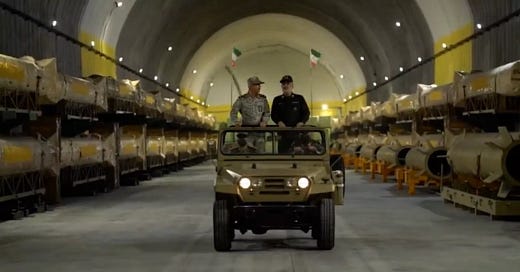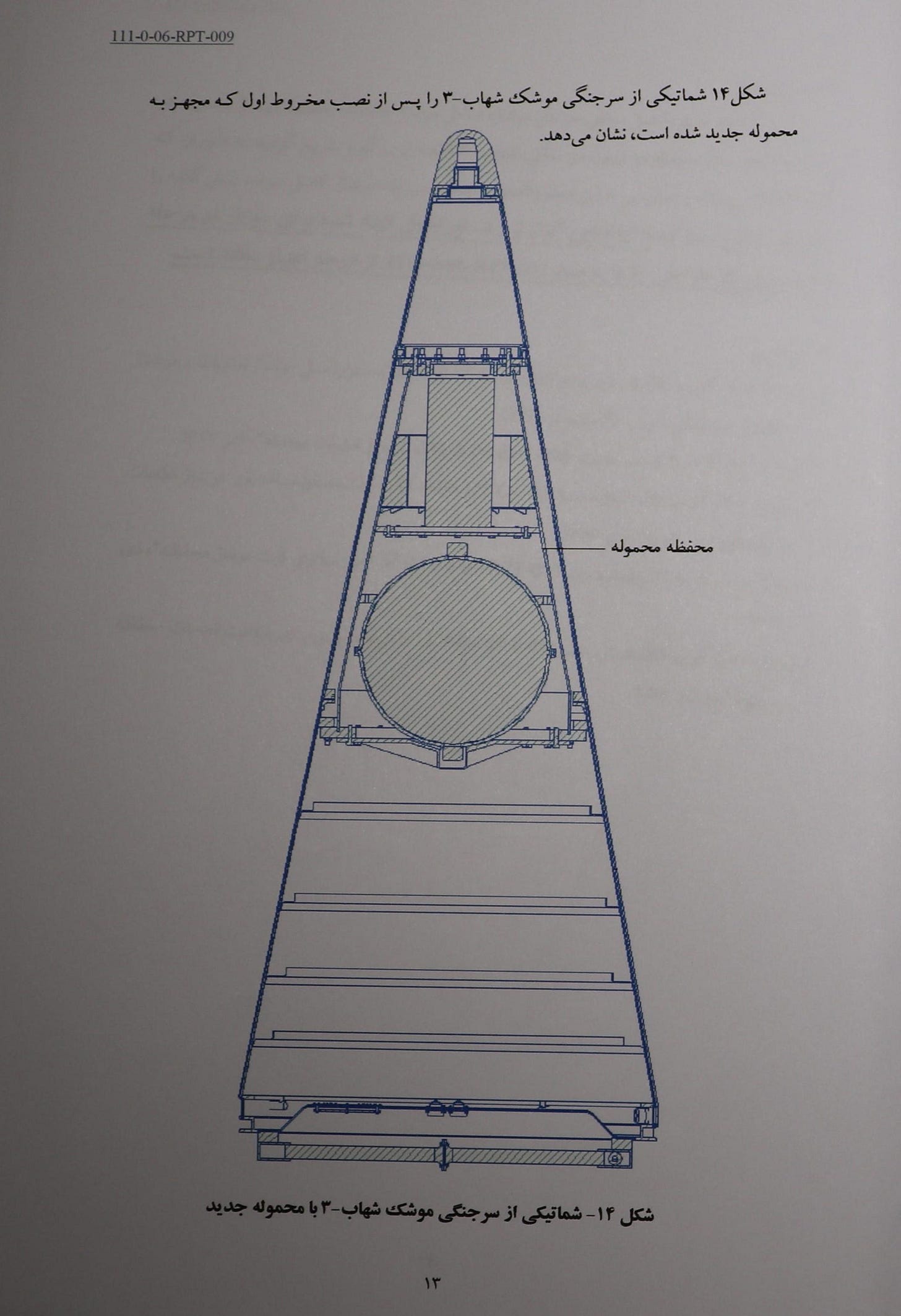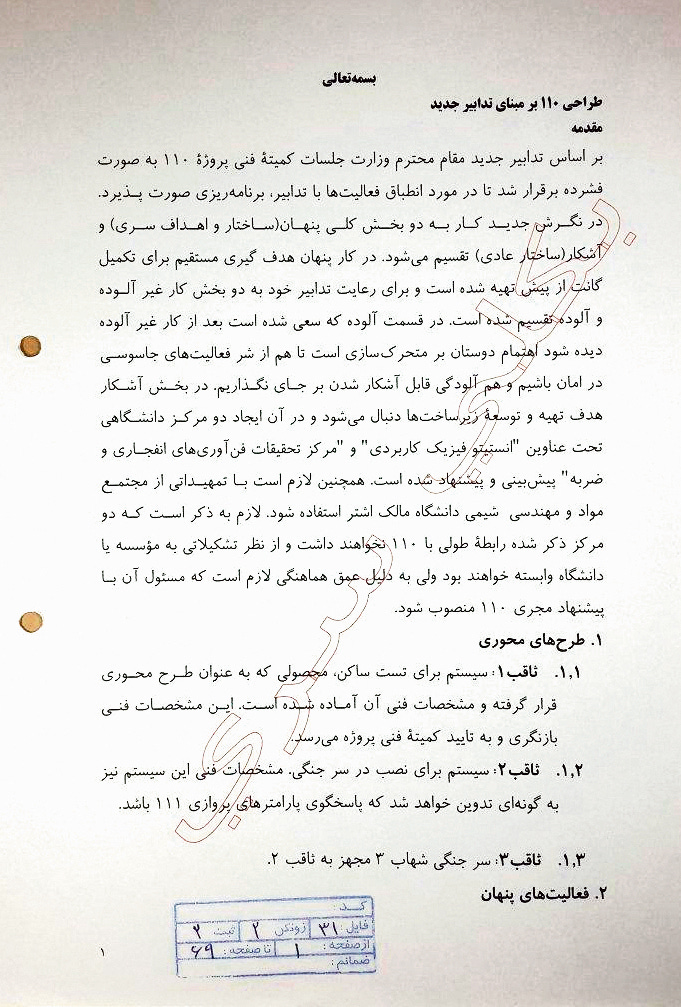Bottom Line Up Front (BLUF)
Iran's nuclear program represents an imminent proliferation threat, with weapons-grade uranium production capability established and historical weapons development infrastructure preserved. Iran's systematic pursuit of nuclear weapons through Project AMAD (1999-2003) and subsequent covert continuation has led to sufficient stockpiles of enriched uranium for approximately 10 nuclear weapons if further enriched, with breakout time reduced to under 4 months.
408.6 kg of 60%-enriched uranium stockpiled (May 2025)
Detection of 83.7%-enriched uranium particles at Fordow (January 2023)
Preserved weapons design archive and technical expertise
Covert weaponization activities under Organization of Defensive Innovation and Research (SPND)
Deep underground facilities beyond conventional military strike capability
1. Historical Context:
Operation Background
In January 2018, Mossad executed Operation "Archive" against a warehouse in Tehran's Shorabad district, extracting over 100,000 documents (55,000 pages, 55,000 digital files) documenting Iran's nuclear weapons program. The 24-agent operation breached 6 of 32 safes over 6.5 hours, using jamming devices and torches to access Iran's most sensitive nuclear secrets.




Project AMAD (1999-2003)
Iran's comprehensive nuclear weapons initiative aimed to develop five nuclear warheads with 10-kiloton yields by mid-2003. The program encompassed:
Weaponization Components:
Over 200 high-explosive tests (1999-2003) for uranium core implosion designs
Computer-simulated nuclear detonations
Warhead designs optimized for Shahab-3 missile integration
Underground test site surveys in Dasht-e Lut desert with geological studies and shaft designs
Production Infrastructure:
Blueprints for "Shahid Boroujerdi" underground facility for uranium core manufacturing
Al Ghadir enrichment plant near Qom for weapons-grade uranium production
Uranium metallurgy operations producing metal discs for neutron initiators
Leadership and Oversight: Supreme Council for Advanced Technologies included:
Hassan Rouhani (then-National Security Advisor, current President)
IRGC Aerospace Commander Amir Ali Hajizadeh
Direct approval from Supreme Leader Ali Khamenei
Foreign Assistance Documentation:
Pakistani A.Q. Khan network centrifuge designs
Russian warhead engineering schematics
North Korean high-explosive testing protocols and shared research data
Deception Operations
The archive revealed systematic IAEA deception through "deception folders" cataloging:
Coordinated false narratives for inspectors
Military site rebranding as civilian facilities (e.g., Fordow)
Equipment concealment and movement protocols



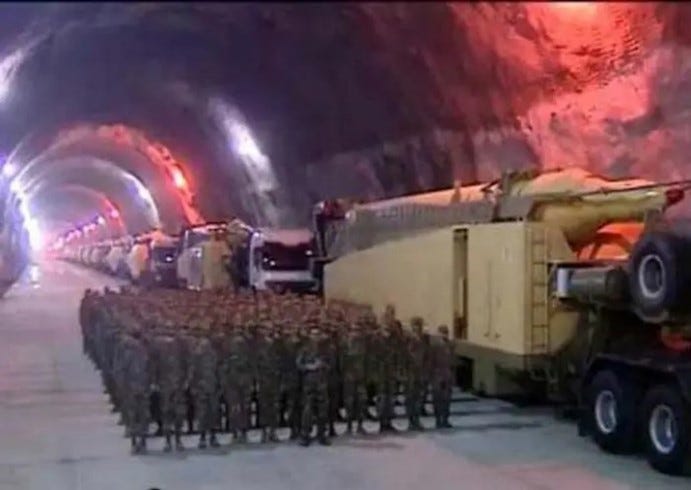
2. Current Nuclear Infrastructure and Capabilities
Uranium Enrichment Status (May 2025)
Stockpile Composition (as of May 17, 2025):
60% Enriched Uranium: 408.6 kg (900.8 pounds) - sufficient for ~10 weapons if further enriched to 90%
Overall Enriched Uranium Stockpile: 9,247.6 kg (20,387.4 pounds) - all enrichment levels combined
Growth Rate: 60% enriched material increased by 133.8 kg (almost 50% increase) since February 2025 report
Total Stockpile Growth: 953.2 kg (2,101.4 pounds) increase across all enrichment levels since February 2025
Production Capacity (Updated May 2025):
60% Enrichment Production Rate: 37 kg per month at Fordow (increased from 4.7 kg/month after feed material upgraded from 5% to 20%)
Breakout Timeline: Less than 4 months to produce sufficient weapons-grade uranium for multiple weapons
Fordow Rapid Production Capability: Can produce weapons-grade uranium for 4 nuclear weapons in 2 weeks, 6 weapons in 1 month using existing infrastructure
Technical Breakthrough: Iran demonstrated ability to enrich to 83.7% - only 6.3 percentage points from weapons-grade
Centrifuge Infrastructure
Natanz Facility:
Over 19,000 gas centrifuges currently operational
New underground facility constructed beyond range of conventional "bunker buster" bombs
18 cascades of IR-2m centrifuges installed (completed November 2024)
IR-4 and IR-6 advanced centrifuges deployed for rapid enrichment
Facility depth: 80-90 meters underground with mountain coverage
Fordow Facility:
Detection of uranium particles enriched to 83.7% (January 2023) - near weapons-grade
Centrifuge reconfiguration without IAEA notification (2023)
Strategic positioning for rapid escalation to weapons-grade production
Critical Detection:
83.7% Uranium Enrichment
Date: January 2023
Location: Fordow Fuel Enrichment Plant (FFEP)
Details: Environmental samples detected uranium particles enriched to 83.7% purity - extremely close to weapons-grade 90% threshold
Iranian Explanation: Claimed as "unintended fluctuations" in centrifuge enrichment levels
IAEA Assessment: No stockpile of 83.7% material accumulated, but detection confirms technical capability
3. Post-2003 Program Continuity and Covert Activities
Organizational Evolution
Following Project AMAD's official termination in 2003, Iran restructured weapons development through:
Organization of Defensive Innovation and Research (SPND):
Established 2011 under Ministry of Defence
Led by Mohsen Fakhrizadeh until his assassination (November 2020)
Continues research under "civilian cover" - neutron initiator development masked as radioisotope production
Operations centered at Karaj facility (IAEA access denied since 2020)
Nuclear Protection Corps (2022):
IRGC unit specifically tasked with nuclear facility protection
Response to security breaches and intelligence penetration
Archive Preservation and Strategic Intent
Iran maintained the nuclear weapons archive until at least 2016, indicating ongoing strategic value:
Documents moved to Shorabad to evade JCPOA-mandated inspections
Serves as "reconstitution blueprint" for weapon assembly
Preserves critical expertise and institutional knowledge
Covert Facility Network
Confirmed Undeclared Sites:
Lavisan-Shian: Uranium metal disc production for neutron sources (2003)
Varamin: Undeclared nuclear material testing
Turquzabad: Secret nuclear activities documented in archive
Suspected Active Sites:
Natanz Sector 6: Tunnel complex potentially housing uranium core production
Parchin: Joint Iran-North Korea hydrodynamics testing (2022) detected via satellite heat signatures
Karaj: Ongoing neutron initiator development (uranium particle traces detected)
4. Regional Proliferation Implications
Saudi Arabian Response
Nuclear Hedging Strategy:
Multinational uranium enrichment consortium proposal with Oman (2025)
Accelerated uranium exploration and reactor projects
Nuclear cooperation MoU with China for two reactors at Jubail (January 2025)
$2 billion Chinese financing for nuclear research center (2024-2025)
Proposed Regional Framework:
Iran enrichment rights on Gulf island (Kish or Qeshm) under IAEA oversight
Limited imports to 3% LEU until consortium operational
Iranian Rejection: "Continuing enrichment on Iranian soil is our red line" - Foreign Minister Abbas Araghchi (2025)
Turkey's Strategic Positioning
Dual-Track Nuclear Policy:
Akkuyu plant Unit 1 scheduled for first power generation (July 2025)
Development of surveillance-capable SAR satellites for regional monitoring
Warning that nuclear war is "no joke" amid regional tensions (2024)
Gulf States Security Arrangements
UAE Nuclear Capabilities:
Barakah Unit 4 fully operational, producing 1,400 MW (April 2025)
All four units now generating total capacity of 5,600 MW
Potential for plutonium extraction if Iran weaponizes
Extended Deterrence Requests:
UAE and Egypt seeking US nuclear security guarantees
Gulf Cooperation Council discussions on collective nuclear response
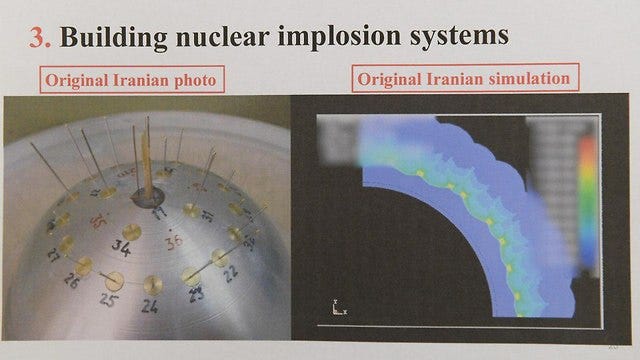
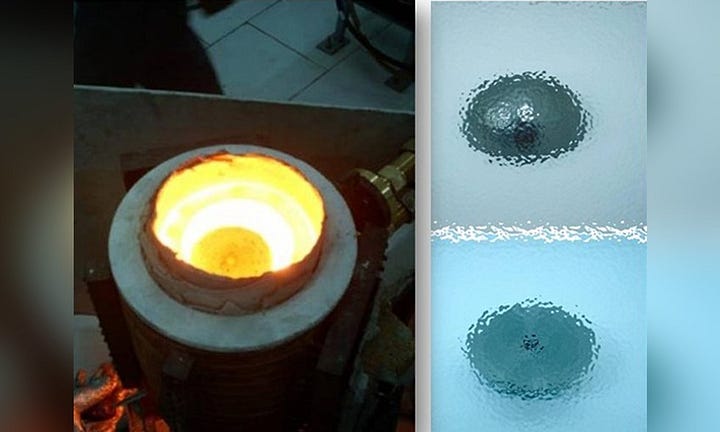


5. Intelligence Gaps and Verification Challenges
IAEA Limitations
Access Denied Locations:
Lavisan-Shian, Varamin, and Fordow inspection restrictions
30+ AMAD-era facilities lack comprehensive documentation
Iran cooperation rated "less than satisfactory" with unresolved uranium traces
Technical Constraints:
Deep underground facilities limit satellite surveillance effectiveness
Compartmentalized SPND operations reduce human intelligence penetration
20 Mossad assets compromised following 2018 archive breach




6. Weapons Development Indicators
Technical Milestones Achieved
Weapons Production Timeline Assessment
Current Capabilities
Enriched Uranium: 900 kg combined stockpile (20% and 60% enriched)
Fissile Material: 408.6 kg of 60% enriched uranium (sufficient for 9–10 weapons if enriched to 90%)
Infrastructure:
Centrifuges: 13,555 advanced centrifuges installed (IR-2m, IR-4, IR-6). : IR-6 centrifuges are 4x more efficient than IR-1. IAEA cannot account for Iran's total centrifuge inventory
Active Cascades: 118 total, 76 advanced (prohibited under original JCPOA). Rapid deployment capability proven (1.5 cascades/week in emergency)
Deployment Rate: 19 cascades in 3 months (6.3/month) - fastest ever recorded
Breakout Scenarios
Current Capacity (No Restrictions)
25 days to produce 25 kg WGU (1 weapon) if 20%/60% stocks eliminated but centrifuges retained
2 months for 4 weapons worth of WGU
5 months for 8 weapons worth of WGU
Near-zero timeline with current 60% stockpile
Current breakout timelines range from weeks to months depending on political constraints, not technical limitations.
JCPOA-Style Limits Reimposed
Assumptions: 6 cascades/month reinstallation rate, stored advanced centrifuges
4.5 months for 25 kg WGU (1 weapon)
7 months for 2 weapons
10 months for 4 weapons
13 months for 6 weapons
Key Factor: Only 40% of excess centrifuges needed by month 5
Conservative Scenario (Slower Reinstallation)
Assumptions: 4 cascades/month at Natanz, 2 at Fordow
5 months for 1 weapon
8 months for 2 weapons
12 months for 4 weapons
Current Readiness Indicators:
Preserved weapon designs and testing data
Trained personnel from AMAD era
Production facilities operational or rapidly reconstitutable
Delivery systems (Shahab-3, potential drone platforms) available
7. International Response and Diplomatic Initiatives
US-Israel Intelligence Coordination
Archive Utilization:
Shared with US, UK, France, Germany, and IAEA (2018)
Influenced US withdrawal from JCPOA (May 2018)
Evidence basis for current sanctions regime
Israeli Kinetic Operations:
Cyberattack on Natanz facility disrupting centrifuge operations (March 2025)
Assassination of Mohsen Fakhrizadeh using AI-assisted robotic attack (November 2020)
October 2024 strikes on Iranian air defenses
European Diplomatic Initiatives
"Modular Deal" Approach:
France/Germany propose incremental sanctions relief
Specific Iranian concessions required (e.g., 60% uranium stockpile caps)
Stalled due to US-Israel opposition
UN Security Council Actions:
Draft resolution on Iran non-compliance tabled by UK and France (May 2025)
UNSCR 2231 enforcement mechanisms under review
IAEA Board of Governors
February 2025 Reports:
Confirmation of secret nuclear activities with undeclared material
Three locations (Lavisan-Shian, Varamin, Turquzabad) violated safeguards
Small-scale tests conducted until early 2000s
8. Economic and Strategic Considerations
Program Financing
Annual Costs:
Nuclear program: ~$3B annually (6% of defense budget)
Offset by sanctions evasion revenue (~$18B from China-backed oil sales)
Procurement Networks:
Dual-use technology transfers through financial institutions
Complex supply chains across multiple jurisdictions
Cryptocurrency and alternative payment systems
Strategic Ambiguity Doctrine
Iran maintains deliberate ambiguity between nuclear latency and weaponization:
Public Position: Civilian nuclear program for energy and medical isotopes
Private Capability: Preserved weapons knowledge and rapid breakout potential
Deterrent Effect: Regional adversaries assume near-weapons capability
Further developments
Natanz FEP IR-6 Centrifuges (October 2022):
Iran installed 522 IR-6 centrifuges in three cascades at Natanz FEP, consistent with IAEA reports.
As of February 2025, operational IR-6 cascades at Natanz FEP increased to six cascades (996 centrifuges), enriching uranium to 5% U-235.
IR-2m and IR-4 Cascade Expansion:
IR-2m cascades: 27 cascades (4,698 centrifuges) operational at Natanz FEP, enriching to 5% U-235.
IR-4 cascades: Iran plans 18 additional cascades (2,988 centrifuges) at Natanz FEP. As of 2025, 12 cascades (1,992 centrifuges) are installed, with 10 operational 11.
November 2024 Expansion Plans:Iran notified the IAEA of intentions to install:
One IR-6 cascade (1,152 centrifuges) at Natanz Pilot Plant (PFEP) for 60% enrichment.
Eight new IR-6 cascades (1,392 centrifuges) at Fordow, supplementing seven existing IR-6 cascades (1,220 centrifuges) enriching to 60% U-23
Foreign Technical Assistance
Russian "Miranda-3" Software: No confirmed deliveries. Unverified claims suggest use for IR-40 reactor optimization (2023), but capabilities/dates unknown 7.
North Korean Personnel: Historical presence (2000s) documented for centrifuge transfers, but no 2024–2025 assignments confirmed 3.
Chinese Financial Networks:
Bank of Kunlun facilitated $1.5B for carbon fiber (500 kg, Jan 2024) and maraging steel (200 tons, Mar 2024) shipments to AEOI/TESA 1.
China CITIC Bank processed $800M for dual-use vacuum pumps (Fordow, 2024) 3.
Impact: Incomplete supply-chain mapping limits sanctions efficacy.
3. SPND Organizational Structure
Leadership: Dr. Ali Akbar Salehi (ex-AEOI head) leads SPND since 2021, reporting to MODAFL 7.
Personnel: ~12,000 AEOI staff:
Natanz: 5,000 (2,500 engineers)
Fordow: 1,200 (600 IRGC security) 7.
Covert Projects:
Tehran Research Reactor: 20% U-235 fuel fabrication (50 tons by 2026).
Khondab Reactor: Redesign for 20 MWt heavy-water reactor (operational 2026) 17.
Impact: Incomplete org charts obscure weaponization progress.
4. Weapons Assembly Timelines
Warhead Assembly: Preserved Amad Plan designs (10-kt implosion device) may require 6–12 months post-enrichment for assembly.
Archived Equipment:
IR-1 centrifuges (~8,000) stored at Natanz (IAEA-monitored).
High-explosive test chambers moved to Parchin (non-operational, IAEA-sealed).
Delivery Systems: Shahab-4 missile (tested Feb 2025) compatible with 500-kg warhead, but no live integration tests.
5. Regional Proliferation Risks
Saudi Arabia:
Uranium mining at Al Rajhi (50 tons/year) and Al Zabirah (100 tons/year by 2027) 1.
Consortium proposal with Iran for regional enrichment, but rejects Iranian oversight 1.
Turkey: Akkuyu reactor (2025 start) uses Russian fuel; no enrichment/reprocessing 10.
UAE: Barakah plant (5.6 GWe) adheres to IAEA safeguards; no plutonium separation 5
Conclusion
Iran's nuclear program represents the most significant proliferation threat in the contemporary international security environment. The combination of preserved weapons designs, substantial enriched uranium stockpiles, and advanced centrifuge capabilities creates conditions for rapid nuclear weapons development. The 2018 archive seizure conclusively demonstrated Iran's historical weapons intent and current capability retention.
Key Judgments:
Iran retains capability to produce nuclear weapons within 4 months using existing infrastructure
Regional proliferation cascade likely if Iran achieves weapons capability
Current diplomatic initiatives insufficient to address scope of threat
Military options remain constrained by underground facility construction
Intelligence coordination essential for effective response
The international community faces a narrowing window for diplomatic resolution before Iran achieves irreversible nuclear weapons capability. Coordinated pressure combining enhanced verification, economic sanctions, and credible deterrence offers the best prospect for preventing Iranian nuclear weapons development and regional proliferation cascade.
End of Brief

